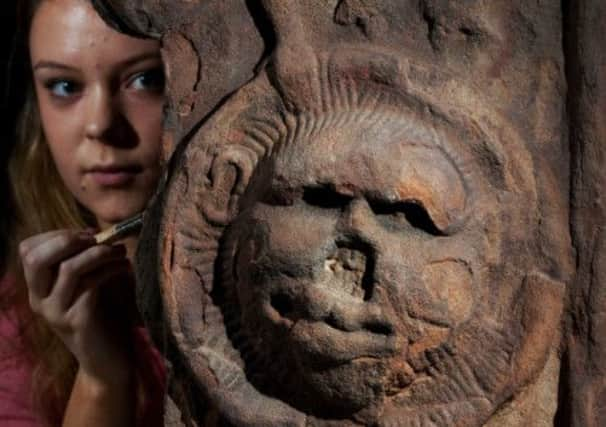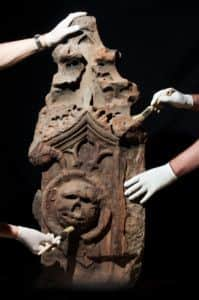Exhibition reveals the real Mary, Queen of Scots


Almost 500 years after her birth she still exerts huge fascination despite the fact her reign as queen in her own right only lasted from 1561 to 1567. Short-lived it may have been, but it was action-packed. Mary’s time on earth was crammed with romance, murder, mystery, betrayals, imprisonment and finally a beheading. The full facts may never be known – was she involved in her second husband’s murder, abducted and raped by her third? Despite the intense scrutiny she has always attracted, it’s not clear.
“Mary is of abiding interest because she was a woman in a man’s world,” says David Forsyth, Senior Curator, Scottish Social History and Diaspora at National Museums Scotland. “She lived at a time when horizons and knowledge were expanding, and was at the heart of it. Then there’s the story of the battle of the cousins, which you could argue Mary ultimately won – Elizabeth died childless and with her the Tudors, while Mary’s Stuart line extended down the centuries to today’s royal family.”
Advertisement
Hide AdEducated, beautiful, powerful, 6ft tall with red hair and alabaster skin, Mary was the It Girl of her day. She had all the glamour of today’s young royals but was ten times more exciting. She led her troops in battle, knew her country – there’s scarcely a castle in Scotland without a plaque reminding us Mary rested her strawberry-blonde head there overnight – and held her own against some of the most difficult and dangerous political animals of her day.


One of a few powerful female Renaissance rulers, Mary wasted no time in becoming queen at six days old in 1542, when her father James V died. Regents ruled Scotland while she was raised in the French court and married the Dauphin, but widowed at 17 Mary returned home, to the consternation of John Knox and the Protestant reformers. Her cousin Elizabeth also feared Mary’s Catholicism and legitimate claims to the English throne. While the rivalry between the two and Mary’s 19 years in captivity are crucial, there’s a lot more to her story than that of the victim queen.
History is hot these days and historical dramas have seen the Tudors top the ratings. Now it’s Mary’s turn with a US series entitled Reign, airing this autumn on the CW Network. Described as Game of Thrones meets Sofia Coppola’s Marie Antoinette, it’s aimed at the Vampire Diaries demographic and its promise of “danger and sexual intrigue around every dark corner” may prove to be more hysterically than historically accurate.
With the facts shrouded in mystery, perhaps it’s easier to understand Mary and explore the past through tangible objects. That’s why I find myself near where she landed in Leith in 1561, in the vast warehouses of the NMS’s Granton store. There are three million plus objects here, including those destined for an exhibition of the queen’s life that will open at the National Museum of Scotland this week.
In it the cult of Mary will be revealed through documents, artefacts and letters, from her first note in Scots to her mother back in Scotland when she was seven, to her final missive on the morning of her execution, asking that her servants be paid. There’s her prized Jesus crown thorn relic, an ivory and mother-of-pearl crossbow, and over on a table, Darren Cox is polishing a dark oak decorative swag from the walls of Mary’s mother’s house. He’s also been buffing up an astrolabe like the ones mariners used to cross the Atlantic in their quests for Eldorado.
“It’s when you have to do a bit of carving on something that you realise the skill they had was amazing, and doesn’t exist any more,” he says.
Advertisement
Hide Ad“We’re the how to look after it side of things,” says Lynn McClean in the spotless letters and textiles conservation room, where they’re working on Mary’s missives and contemporary books. “Our aim is to make things last longer so people see them. These letters had ingrained dirt, and have had quite a history - you want to preserve that too. She sat there with this piece of paper, touched it, signed it; it’s amazing to work on them,” she says.
Getting hands-on also appeals to George Dalgleish, Keeper, Scottish History and Archaeology at National Museums Scotland, who is particularly excited about the inclusion of the Penicuik Jewels in the exhibition. In his office in the Chambers Street museum, metres from the spot where the body of Lord Darnley was discovered, he dons white gloves and carefully lifts the gold necklace and cameo pendant worn by the queen to the end, along with two pendants that contain tiny portraits believed to be of Mary and her son James VI.
Advertisement
Hide Ad“There is very little of her material you can hand-on-heart say definitely belonged to her,” he says. “The closest we have to that historical nirvana is the Penicuik Jewels,” he says.
The jewels were given to the museum by the Clerk family, one of whom had married the granddaughter of one of Mary’s maids-of-honour. It’s on record the queen gave her jewels just before being executed at Fotheringay.
“We can say the necklace and heart jewel were hers. The necklace was possibly originally part of a rosary and contained perfume. The heart locket is late 16th century, and the cameo is Mary, with the surround added later. The other two were possibly made to be given as gifts by Mary,” he says.
While the jewels reveal a lot about Mary, they also tell us about Scotland’s place in a rapidly changing world.
“The Scots nobility were well aware of European fashions – Mary wouldn’t have been married to the Dauphin if Scotland had been a barbaric country of savages. It had a substantial dynastic importance, sitting between competing power blocks, and punched above its weight,” says Dalgleish.
David Forsyth also sees the exhibition as an opportunity for visitors to appreciate the bigger picture of the role Mary and Scotland played on the world stage.
Advertisement
Hide Ad“This is the first time a major exhibition has brought together documents, maps, letters, paintings, jewellery and objects. It’s a once-in-a-lifetime opportunity. Objects have a resonance; the thorn, the prayer book, jewels. People in the past touched them and that’s what’s important,” says Forsyth.
Apart from Mary’s belongings there will also be contemporary objects that reflect the explosion of learning that was taking place, such as one of the first modern atlases, the Theatrum Orbis Terrarum, made by Abraham Ortelius of Antwerp in 1570. This shows Scotland complete with Barwick [Berwick-upon-Tweed] as big as Edinburgh, Glasquo [Glasgow} and Dunbar, and the whole country displayed on its side, as if approached from the Low Countries rather than Westminster.
Advertisement
Hide Ad“We’re really keen to get away from the slightly hackneyed story of Elizabeth and Mary, and her years in captivity and look at her as a Renaissance monarch,” says Forsyth. “Her rule in Scotland has been overlooked. She’s not just a frivolous young woman who likes dancing but was well-educated and governs properly, and unusually, leads her troops in battle. She really was something else, especially when you look at the men around her. I hope people will see her in a wider context and get a fresh insight. She’s long overdue that reappraisal.”
• Mary, Queen of Scots, National Museums Scotland, Chambers Street, Edinburgh, Friday to 17 November, is supported by Baillie Gifford investment managers (www.nms.ac.uk/mary).